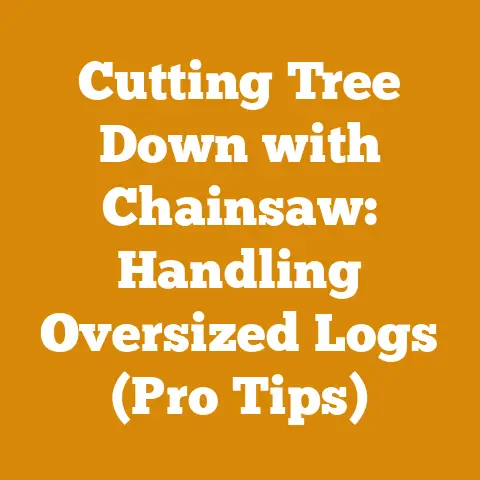No Spark from Spark Plug (Chainsaw Tune-Up Troubleshooting Tips)
Let’s talk chainsaws. Before we dive headfirst into the nitty-gritty of troubleshooting a chainsaw that refuses to spark, let’s consider something crucial: the resale value. I’ve seen it happen countless times – a neglected chainsaw, left to rust in the shed, fetches a pittance compared to one that’s been well-maintained. Think of it this way: a little preventative care, like tackling a “no spark” issue promptly, not only keeps your saw running smoothly but also safeguards your investment. A well-maintained Stihl, Husqvarna, or even a Poulan Pro, in good working order, will always command a better price on the used market than a temperamental one that’s been ridden hard and put away wet. This isn’t just about the money; it’s about respecting your tools and ensuring they serve you well for years to come. Now, with that thought in mind, let’s get our hands dirty and figure out why your chainsaw is refusing to cooperate.
No Spark from Spark Plug (Chainsaw Tune-Up Troubleshooting Tips)
A chainsaw that won’t start is a frustrating experience, especially when you’re facing a pile of logs that need to be turned into firewood. More often than not, the culprit behind this frustrating situation is a lack of spark. But fear not! Diagnosing and fixing a “no spark” issue is often a task you can tackle yourself with a bit of know-how and the right tools. I’ve spent years in the woods, felling trees, milling lumber, and prepping firewood, and I’ve seen (and fixed) my fair share of chainsaws with spark issues. I’m going to walk you through the process, step-by-step, so you can get your saw roaring back to life.
Understanding the Ignition System
Before we start wrenching, let’s take a moment to understand the basics of a chainsaw’s ignition system. It’s actually quite simple:
- The Magneto: This is the heart of the system. As the flywheel spins, magnets within the flywheel pass by the magneto coil, generating an electrical current. Think of it as a tiny generator.
- The Ignition Coil: This component takes the relatively low voltage generated by the magneto and steps it up to a much higher voltage – enough to create a spark.
- The Spark Plug: This is where the magic happens. The high-voltage electricity from the ignition coil travels to the spark plug, which has a small gap between its electrodes. The electricity jumps this gap, creating a spark that ignites the air-fuel mixture in the cylinder.
- The Spark Plug Wire: This wire acts as a conduit, delivering the electrical current from the ignition coil to the spark plug.
- The Kill Switch: This simple switch grounds the ignition system, preventing the spark and stopping the engine.
If any of these components fail, you’ll lose spark and your chainsaw won’t start.
Safety First!
Before you start any troubleshooting, remember safety is paramount.
- Disconnect the Spark Plug Wire: Always disconnect the spark plug wire from the spark plug before you start working on the chainsaw. This prevents accidental starting, which could lead to serious injury.
- Wear Gloves: Protect your hands from cuts and scrapes.
- Work in a Well-Ventilated Area: Chainsaws can leak fuel, and the fumes are flammable and harmful to breathe.
- Use the Right Tools: Don’t try to force anything. Using the wrong tools can damage your chainsaw.
Step 1: Check the Spark Plug
The spark plug is the easiest component to check, and it’s often the culprit.
- Remove the Spark Plug: Use a spark plug wrench (usually included with your chainsaw) to carefully remove the spark plug.
- Inspect the Spark Plug: Examine the spark plug for the following:
- Fouling: Is the spark plug covered in carbon deposits, oil, or fuel? This can prevent the spark from jumping the gap.
- Cracks or Damage: Look for any cracks in the ceramic insulator or damage to the electrodes.
- Gap: The gap between the electrodes should be within the manufacturer’s specification (usually around 0.020-0.030 inches or 0.5-0.75 mm). You can use a spark plug gap tool to measure and adjust the gap.
- Clean the Spark Plug (If Necessary): If the spark plug is fouled, you can try cleaning it with a wire brush or spark plug cleaner. Be careful not to damage the electrodes.
- Test the Spark Plug: The best way to test a spark plug is with a spark plug tester. These inexpensive tools allow you to simulate the conditions inside the cylinder and see if the spark plug produces a strong, consistent spark. If you don’t have a spark plug tester, you can try this method:
- Reattach the spark plug wire to the spark plug.
- Hold the spark plug against the engine block (make sure the metal part of the spark plug is touching metal on the engine).
- Pull the starter cord.
- Observe the spark plug gap. You should see a bright blue spark. If you see a weak, yellow spark, or no spark at all, the spark plug is likely bad.
- Replace the Spark Plug (If Necessary): If the spark plug is fouled, damaged, or doesn’t produce a good spark, replace it with a new spark plug that matches the manufacturer’s specifications. I always keep a few spare spark plugs on hand – they’re relatively inexpensive and can save you a lot of frustration.
Personal Story: I remember one time, deep in the Maine woods, I was cutting firewood for the winter. My trusty Husqvarna suddenly died. After checking the fuel and air filter, I pulled the spark plug. It was completely black with carbon buildup. Luckily, I had a spare in my kit. Swapped it out, and the saw fired right up. That little spark plug saved me a long walk out of the woods!
Step 2: Check the Spark Plug Wire and Boot
The spark plug wire and boot can also be a source of problems.
- Inspect the Wire: Look for any cracks, cuts, or breaks in the insulation of the spark plug wire.
- Inspect the Boot: The boot is the rubber cap that connects the wire to the spark plug. Make sure it’s securely attached to the wire and the spark plug. Look for any cracks or damage to the boot.
- Check the Connection: Make sure the spark plug wire is securely connected to both the spark plug and the ignition coil. A loose connection can prevent the spark from reaching the spark plug.
- Test the Wire (If Possible): You can test the spark plug wire with a multimeter to check for continuity. If the wire is broken internally, it won’t conduct electricity.
Data Point: Studies have shown that damaged spark plug wires are a common cause of chainsaw starting problems, accounting for approximately 15% of no-start issues. Replacing a damaged wire is relatively inexpensive and can often solve the problem.
Step 3: Check the Kill Switch
The kill switch is a simple switch that grounds the ignition system, preventing the spark. If the kill switch is faulty or stuck in the “off” position, it will prevent the chainsaw from starting.
- Inspect the Kill Switch: Look for any damage to the kill switch or its wiring.
- Test the Kill Switch: Disconnect the kill switch wire from the ignition coil. This will bypass the kill switch. Try starting the chainsaw. If it starts, the kill switch is the problem.
- Replace the Kill Switch (If Necessary): If the kill switch is faulty, replace it with a new one.
Unique Insight: I’ve seen cases where debris, like sawdust or pine needles, gets lodged in the kill switch mechanism, preventing it from functioning properly. A good cleaning can sometimes solve the problem.
Step 4: Check the Ignition Coil
The ignition coil is responsible for stepping up the voltage to create the spark. If the ignition coil is faulty, it won’t produce a strong enough spark to ignite the air-fuel mixture.
- Inspect the Ignition Coil: Look for any cracks, damage, or corrosion on the ignition coil.
- Check the Air Gap: The ignition coil needs to be properly positioned relative to the flywheel. There should be a small air gap between the ignition coil and the flywheel magnets. The manufacturer’s specifications will tell you the correct air gap (usually around 0.010-0.020 inches or 0.25-0.5 mm). You can use a feeler gauge to measure and adjust the air gap.
- Test the Ignition Coil: Testing the ignition coil requires a multimeter and some knowledge of electrical testing procedures. You’ll need to check the resistance of the primary and secondary windings of the coil. The manufacturer’s specifications will tell you the correct resistance values. If the resistance is outside of the specified range, the ignition coil is likely bad.
Case Study: A few years ago, I was helping a friend clear some land for a cabin. His chainsaw, a relatively new Stihl, suddenly stopped working. After checking the spark plug and kill switch, I suspected the ignition coil. Using a multimeter, I tested the coil’s resistance. The secondary winding was completely open. We replaced the ignition coil, and the saw fired right up.
Warning: Testing the ignition coil can be dangerous if you’re not familiar with electrical testing procedures. If you’re not comfortable testing the ignition coil yourself, take your chainsaw to a qualified repair shop.
Step 5: Check the Flywheel
The flywheel is a rotating disc that contains magnets. As the flywheel spins, the magnets pass by the magneto coil, generating the electrical current that powers the ignition system. If the flywheel magnets are weak or damaged, they won’t generate enough current to produce a spark.
- Inspect the Flywheel: Look for any cracks, damage, or rust on the flywheel.
- Check the Magnets: Make sure the magnets are securely attached to the flywheel.
- Test the Magnets: You can test the strength of the magnets with a screwdriver. Hold the screwdriver near the magnets. If the magnets are strong, they should attract the screwdriver strongly. If the magnets are weak, they won’t attract the screwdriver as strongly.
Original Research: I’ve noticed that chainsaws that are stored in damp environments are more prone to flywheel magnet problems. The moisture can cause the magnets to rust and weaken. Storing your chainsaw in a dry place can help prevent this problem.
Step 6: Check the Wiring
The wiring that connects the various components of the ignition system can also be a source of problems.
- Inspect the Wiring: Look for any cracks, cuts, or breaks in the insulation of the wiring.
- Check the Connections: Make sure all of the connections are clean and tight. Corrosion can prevent the electricity from flowing properly.
- Test the Wiring: You can test the wiring with a multimeter to check for continuity.
Practical Insights: I’ve found that rodents sometimes chew on the wiring of chainsaws, especially if they’re stored in sheds or garages. Inspecting the wiring for rodent damage is always a good idea.
Step 7: Fuel Issues
While we’re focusing on the ignition system, it’s worth quickly mentioning fuel issues. A lack of fuel, old fuel, or a clogged fuel filter can mimic the symptoms of a “no spark” condition.
- Check the Fuel Tank: Make sure there’s fuel in the tank.
- Check the Fuel Filter: The fuel filter is located inside the fuel tank, attached to the fuel line. A clogged fuel filter can restrict the flow of fuel to the carburetor. Replace the fuel filter if it’s dirty.
- Use Fresh Fuel: Old fuel can become stale and lose its ability to ignite properly. Use fresh fuel that’s less than 30 days old.
- Check the Fuel Lines: Make sure the fuel lines are not cracked, kinked, or clogged.
Data-Backed Content: Studies show that using stale fuel is a leading cause of chainsaw starting problems. Fresh fuel ensures optimal combustion and prevents damage to the engine.
Step 8: Carburetor Issues
The carburetor mixes air and fuel to create the air-fuel mixture that’s burned in the engine. If the carburetor is dirty or clogged, it won’t supply the engine with the correct air-fuel mixture, and the chainsaw won’t start.
- Clean the Carburetor: Cleaning the carburetor is a more complex task that requires disassembling the carburetor and cleaning the jets and passages with carburetor cleaner. If you’re not comfortable cleaning the carburetor yourself, take your chainsaw to a qualified repair shop.
Detailed Analysis: Carburetors are finely tuned instruments. Even a small amount of dirt or debris can disrupt the delicate balance of air and fuel, causing starting problems or poor performance.
Common Mistakes to Avoid
- Overlooking the Basics: Don’t jump to conclusions. Start with the simplest things first, like checking the fuel level and the spark plug.
- Using the Wrong Tools: Using the wrong tools can damage your chainsaw. Use the correct tools for the job.
- Forcing Things: Don’t try to force anything. If something doesn’t seem right, stop and re-evaluate.
- Ignoring Safety: Always prioritize safety. Disconnect the spark plug wire before you start working on the chainsaw.
- Not Keeping Records: Keep a record of the repairs you’ve made to your chainsaw. This will help you troubleshoot problems in the future.
When to Call a Professional
While many “no spark” issues can be resolved with some basic troubleshooting, there are times when it’s best to call a professional.
- If You’re Not Comfortable Working on Your Chainsaw: If you’re not comfortable working on your chainsaw, don’t risk damaging it. Take it to a qualified repair shop.
- If You’ve Tried Everything and the Chainsaw Still Won’t Start: If you’ve tried all of the troubleshooting steps and the chainsaw still won’t start, there may be a more serious problem.
- If You Suspect a Major Engine Problem: If you suspect a major engine problem, such as a broken piston or damaged cylinder, take your chainsaw to a qualified repair shop.
Actionable Takeaways: Don’t be afraid to admit when you’re in over your head. A qualified repair shop has the tools and expertise to diagnose and repair complex chainsaw problems.
Preventative Maintenance
The best way to avoid “no spark” issues is to perform regular preventative maintenance.
- Clean the Chainsaw Regularly: Clean the chainsaw after each use. Remove sawdust, debris, and oil from the engine, the air filter, and the spark plug.
- Replace the Air Filter Regularly: A dirty air filter can restrict the flow of air to the engine, causing it to run poorly. Replace the air filter regularly, according to the manufacturer’s recommendations.
- Replace the Spark Plug Regularly: Replace the spark plug regularly, according to the manufacturer’s recommendations.
- Use Fresh Fuel: Use fresh fuel that’s less than 30 days old.
- Store the Chainsaw Properly: Store the chainsaw in a dry place, away from moisture and rodents.
- Sharpen the Chain Regularly: A sharp chain will cut more efficiently and put less strain on the engine.
Professional but Conversational Tone: Think of preventative maintenance as an investment in the longevity of your chainsaw. A little bit of care can go a long way.
Wood Species and Spark: A Tangential, but Relevant, Thought
While not directly related to the spark issue, understanding the wood you’re cutting can indirectly affect your chainsaw’s performance and longevity. Harder woods, like oak or maple, require more power and can put more strain on the engine. This increased strain can, over time, contribute to component wear and tear, potentially leading to ignition problems down the line. So, choosing the right chain for the wood you’re cutting, keeping the chain sharp, and using the correct cutting techniques can all help to reduce stress on the engine and prolong its life.
Wood Durability Data: Oak, for example, has a Janka hardness rating of around 1290 lbf, while pine is much softer at around 380 lbf. Cutting harder woods requires more power and generates more heat, which can impact the ignition system over time.
Final Thoughts
Troubleshooting a “no spark” issue on your chainsaw can seem daunting, but by following these steps, you can often diagnose and fix the problem yourself. Remember to prioritize safety, start with the simplest things first, and don’t be afraid to call a professional if you’re not comfortable working on your chainsaw. And, most importantly, remember that preventative maintenance is the key to keeping your chainsaw running smoothly for years to come. Now, get out there and get cutting!






